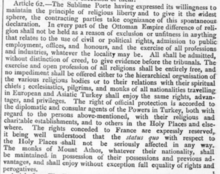Status quo (Holy Land sites)

"The rights conceded to France are expressly reserved, it being well understood that the status quo with respect to the Holy Places shall not be seriously affected in any way."

The status quo of the Holy Land sites resulted from a firman (decree) of Ottoman Sultan Osman III in the 18th century[1] that preserved the division of ownership and responsibilities of various sites important to Christians, Muslims, and Jews to their then current holders or owners. The actual provisions of the status quo were never formally established and represented agreements among the various religions that nothing could be changed from the way it was without upsetting the balance of order in maintaining the religious sites for visits by pilgrims.
When the Greeks launched a Palm Sunday takeover of various Holy Land sites in 1757[2] the Ottomans subsequently upheld this status quo.[3]
This status quo for Jerusalem meant that certain statuses for the Holy Sites would be kept and were recognized as being permanent or at least the way things should be. The city was divided into four quarters. The Temple Mount became a Muslim holy place, and the Church of the Holy Sepulchre as well as other various Christian sites were recognized as belonging to the Christian world. Despite the arguments over who would control what aspects of these sites, the status quo has remained largely intact from the 17th century to the present. Although claims that this status quo was being violated led to the 1929 Palestine riots, it has not been changed, and the quarters and areas remain roughly as they have been inside Suleiman's walls.
A further 1853 decree,[4] in the wake of the events leading to the Crimean War, solidified the existing territorial division among the communities and set a status quo for arrangements to "remain forever", caused differences of opinion about upkeep and even minor changes,[5] including disagreement on the removal of an exterior ladder under one of the windows; this ladder has remained in the same position since then.
Under the status quo, no part of what is designated as common territory may be so much as rearranged without consent from all communities. This often leads to the neglect of badly needed repairs when the communities cannot come to an agreement among themselves about the final shape of a project. Just such a disagreement has delayed the renovations of most pilgrimage sites, and also where any change in the structure might result in a change to the status quo, disagreeable to one or more of the communities.
Bibliography
- Marlen Eordegian (2003), British and Israeli Maintenance of the Status Quo in the Holy Places of Christendom, International Journal of Middle East Studies, Vol. 35, No. 2 (May, 2003), pp. 307-328
See also
- Church of the Holy Sepulchre#Status quo
- Church of the Nativity#Current administration
- Simultaneum
- Temple Mount entry restrictions
References
- ↑ Cities of the Middle East and North Africa: A Historical Encyclopedia, edited by Michael Dumper, Bruce E. Stanley P 209
- ↑ The Church of the Holy Sepulchre:A Work in Progress, by Raymond Cohen
- ↑
- ↑ The Church of the Holy Sepulchre:A Work in Progress, by Raymond Cohen
- ↑ The Church of the Holy Sepulchre:A Work in Progress, by Raymond Cohen